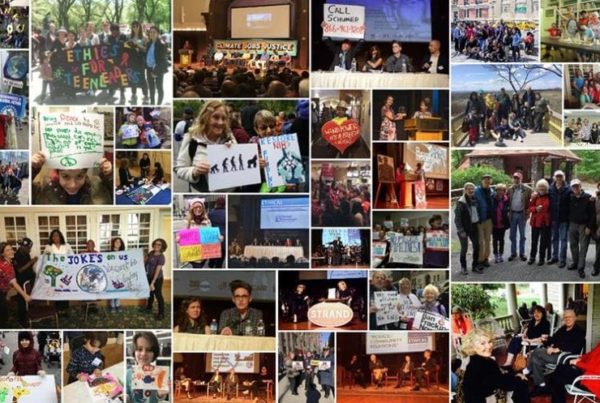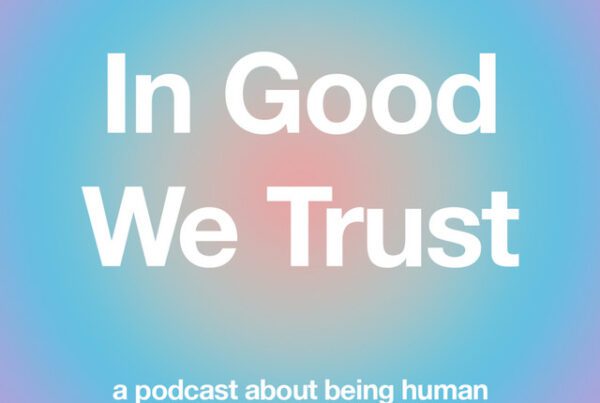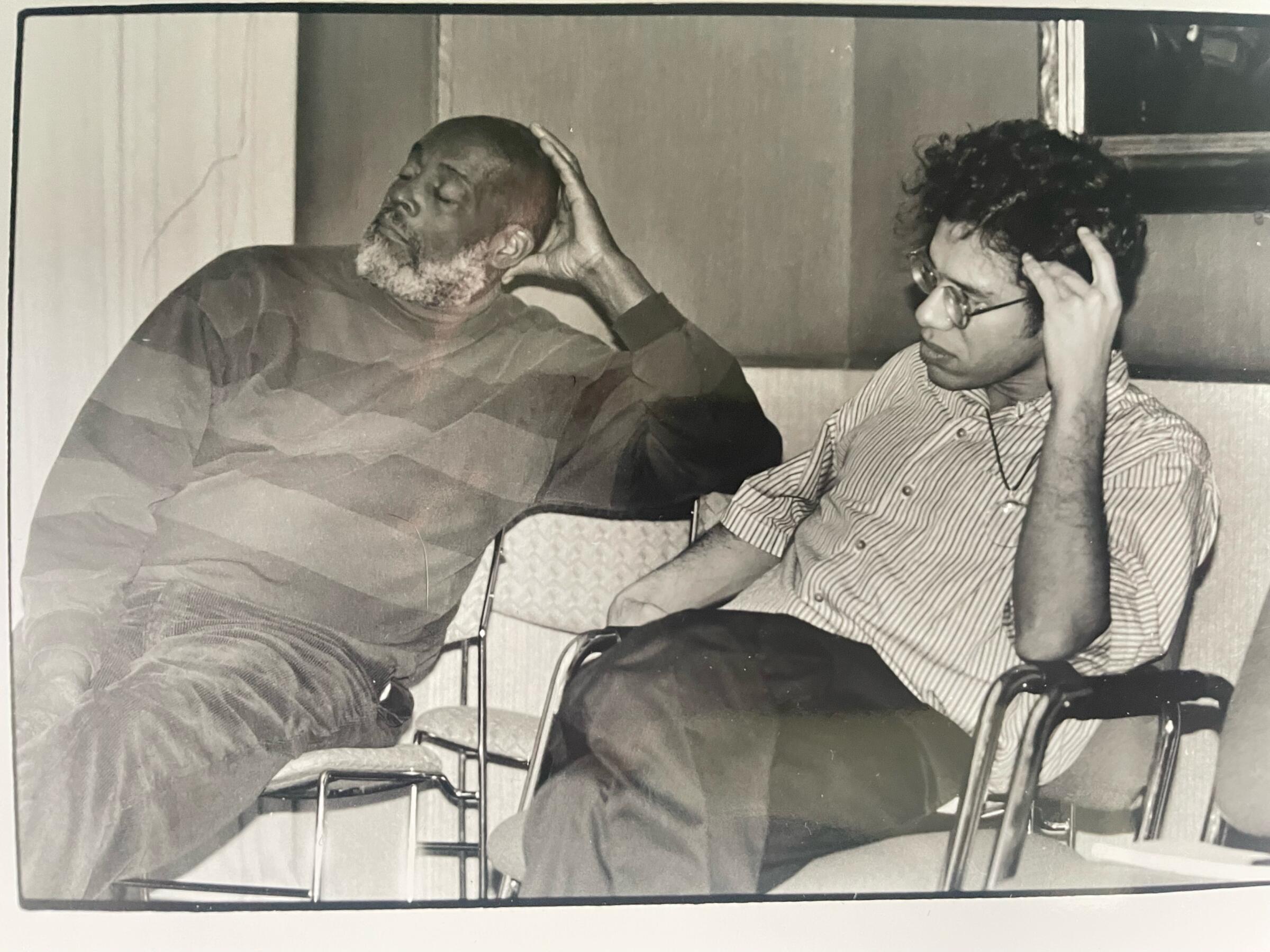
This is the first in a series of posts focusing on our Ethical Heroes. The series will to be posted throughout our Founders Month of May.
The Mel King Universe, From a Disciple
By Sean I. Robin
Article first published by Progressive City: Radical Alternatives
Photos by Skip Schiel, copyright 1996. teeksaphoto.org
Sean I. Robin is a member of Ethical NYC. He is the former editor of Indigenous Planning Times and a convener of the BIPOC Planning Collective, an affiliate of Planners Network. He is currently Assistant Commissioner of Co-op Readiness at the New York City Department of Housing, Preservation and Development. He studied urban planning at MIT.
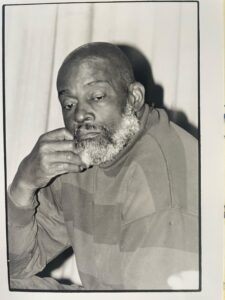 There is a Mel King Universe (Multiverse, Cosmos…) that you enter when you go to one of his meetings or Sunday brunches. In this Universe, everything is still possible and waiting to be done. The Civil Rights Movement continues to rage, never having missed a beat. You immediately begin to fault yourself for your own prior pessimism in accepting things as they were. Change now seems inevitable, rather than an unjust status quo. And you have been enlisted to help carry it out. Afro-pessimism does not fit through the door of this place, or anything that even hints of defeatism. There must have been a magical tea he was serving that alters your perception of reality in his presence, and in the presence of the group, the community he was constantly lending a hand in assembling. A Mel King assembly was not just a bunching together of folk any which way; rather, it always became something purposeful and loving for the Movement. We were made to recall that there was still a Movement, in fact, and that we could no longer afford to be absent. The week’s assignments no longer seemed relevant, so much as solving the problem of income inequality, land dispossession or world hunger. The solution always seems just within reach if we would only strive a bit harder, dispensing with the more superficial things in life. Anything less and one felt one had become a conservative, just in it for oneself. Or as Professor King once put it to my first year planning class, “If you don’t see this work as being about social justice, then it’s a complete waste of time.” In the Mel King Universe, there are no intractable problems, only brilliant people waiting to do what is needed—and the resources are abundant.
There is a Mel King Universe (Multiverse, Cosmos…) that you enter when you go to one of his meetings or Sunday brunches. In this Universe, everything is still possible and waiting to be done. The Civil Rights Movement continues to rage, never having missed a beat. You immediately begin to fault yourself for your own prior pessimism in accepting things as they were. Change now seems inevitable, rather than an unjust status quo. And you have been enlisted to help carry it out. Afro-pessimism does not fit through the door of this place, or anything that even hints of defeatism. There must have been a magical tea he was serving that alters your perception of reality in his presence, and in the presence of the group, the community he was constantly lending a hand in assembling. A Mel King assembly was not just a bunching together of folk any which way; rather, it always became something purposeful and loving for the Movement. We were made to recall that there was still a Movement, in fact, and that we could no longer afford to be absent. The week’s assignments no longer seemed relevant, so much as solving the problem of income inequality, land dispossession or world hunger. The solution always seems just within reach if we would only strive a bit harder, dispensing with the more superficial things in life. Anything less and one felt one had become a conservative, just in it for oneself. Or as Professor King once put it to my first year planning class, “If you don’t see this work as being about social justice, then it’s a complete waste of time.” In the Mel King Universe, there are no intractable problems, only brilliant people waiting to do what is needed—and the resources are abundant.
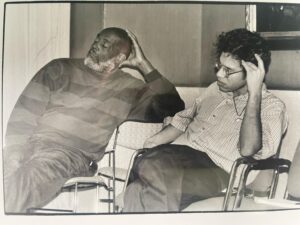

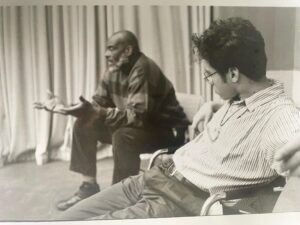

One of Mel King’s legacies was his longevity as an activist, a powerbroker, and an educator. His very presence in the 1980s, 90s, and into the New Millennium showed us the lie in the history books that the Civil Rights Movement ended in 1968 with the death of Martin Luther King. He once said he was more impressed with Rosa Parks, a much more humble woman in the Struggle, who also lived into her 90s. Mel King came of age in the Civil Rights Era, and passed into both the Black Power Movement and the Counterculture, absorbing important elements and energies of all three. In the process, he forged his own distinct brand: the Rainbow Coalition. His Vision, the Mel King Universe, thus championed integration into mainstream venues as well as the creation of Black Institutions—both of these peppered with messages of Peace and Love. He was a militant while also being anti-military; anti-technologies of war and killing. For all three of these movements, the fires were still burning strong in him. He led us to ask how could we even think to put the Civil Rights Movement behind us if its broader goal of Black Emancipation had yet to be fully realized? Why would we shun Black Power if African Americans still do not have a solid seat at the table in America’s corridors of power?
Regarding the Counterculture, Michael Jones describes Mel King’s “bearing and speaking style” as that of “an Eastern mystic” in a recent tribute. When he spoke, there were long pregnant pauses where he would close his eyes and then there would be a fluttering of his lids, such that he seemed to be meditating at the same time as he was speaking. We all wanted to access that other realm he seemed to be tapping into. When I once bemoaned having missed the excitement of the 1960s, he replied, “the Revolution is happening every day.” And in the same breath, “What we need is a Revolution in Love.” If as an organizer, his focus was enabling Black and other dispossessed peoples to gain access to power, it was certainly not a militaristic or coercive form of power. His MIT retirement conference was entitled, “The Love of Power and the Power of Love.” The first, he said, “builds fences” whereas, “the Power of Love opens doors.” He believed this was the kind of power that is infinite, belying a “politics of scarcity” that had been put upon the populace.
The concept of “Planning without a Plan,” which he co-authored with Marie Kennedy, recalls the “Original Mind” and “Emptiness” of Zen Buddhism. Or, as he put it, it was a reminder to first listen deep and intently as a planner. I don’t recall who he was riffing off when he constantly quoted, “To truly listen means to be willing to change.”
I was pulled into the Mel King Universe because I had left my native New York to study in Boston at the MIT Department of Urban Studies and Planning, where Mel King was a professor. His very presence within the Department was a principal factor in my decision to choose that school in the first place. He was trained as an educator and came of age as a community organizer of youth, an emphasis he maintained throughout his life. And yet he clearly saw planning and technology as key moments in the Struggle. Being a Race Man, as they used to say, he championed the access of Black and other People of Color, as well as working class people, to the resources of this elite center of learning. There should be no second class education for those he knew to be first class folks. My fellow student Renée Okamura recently told me, “If it wasn’t for Mel, I don’t think I would have made it through.”
I was part of a band of students of color “and Rainbow Allies” in 1989 who were dissatisfied with the near absence of the perspectives of Communities of Color in the core planning curriculum. Emboldened by Mel King, we did a counter presentation to our incoming class, on what we thought planning should consist of. We then went on to organize our own course, with Mel advising, called, “Planning in Communities of Color.” Each week a different student would present a case study from her own urban community and culture. If MIT had taught that there were four paradigms, we called ourselves in search of “the fifth paradigm” that would speak from the rich voices, perspectives and cosmologies of our own peoples. We came to call this paradigm Indigenous Planning, representing activist perspectives from the Black, Latino, Asian and Native American communities. In those days we used “indigenous” to refer to from within, drawing upon our own resources, talents and heritage. Mel uses the word in his book, and I later found that Mahatma Gandhi used the word with a strong anti-colonial valence as far back as 1914. Today the term Indigenous Planning has been reclaimed by First Nations peoples to refer specifically to planning by Original Peoples. We might now instead use terms like Reparatory, Restorative and Abolitionist Planning. In an article for the subsequent publication Indigenous Planning Times, which ran for a decade, Marie Kennedy uses the term Transformative Community Planning for this new approach to planning, which goes several steps beyond Advocacy and Participatory Planning. She also comments, “It doesn’t matter what you call it, just that you do it.” My classmates Maria Cabildo and Renée Okamura described this approach as follows:
People in the community are entrusted to decide their planning objectives and the appropriate planning processes to achieve them. The professional’s role is not to direct or control planning in a community, but to provide the technical expertise to empower the community to make its own decisions, to develop and control its own resources.
In authentic planning of this sort, the process, along with the results, will have local color, a vernacular and homespun feel. Emerging from the people of this place it will not have the look and touch of a standardized product transported from elsewhere. It will be of the sound and texture of the people’s culture and heritage. It may also need to confront dominant, sometimes global forces to do so. Mel once said, “If you don’t feel yourself bumping up against something, it could be that nothing is actually changing.”
Given the profound impression Mel King made upon us, I have often wondered why Mel is not better known outside of Boston. In his hometown, he is truly beloved and is now being eulogized for helping heal (really only begin to heal) the city’s racial divides, particularly as exposed during the 1970s era of busing for school desegregation. Did he make a conscious choice to stay local and shun a bigger platform, in terms of geography? He believed in decentralization of control to the neighborhood level, and was perhaps not interested in leaving his beloved South End neighborhood. He was content to have the Reverend Jesse Jackson take his Rainbow Coalition national for him, as one of the links in his “chain of change.” Mel King was of a special branch of the Civil Rights Movement that focused on local community development—issues of Housing, Jobs, Education, and yes, culture. While remaining local he in fact grew the legacy of the Struggle around issues that planners care about. He was less concerned with creating a Master Plan or Grand Political Strategy than he was in kicking up a process of change that would take root in the right way.
Mel King turned development on its head, frequently quoting the Tanzanian Leader Julius Nyerere (he was our Nyerere more than he was our Nelson Mandela). He taught a class entitled “Peace, Justice and Development,” where it soon became clear that we would be co-responsible for the course’s content—another Zen trick. In his class, we were encouraged to explore development as the development of people, rather than a focus on brick and mortar. In this light, the community development movement nationally often seems to have lost its way when it focuses on the housing crisis in isolation, and seeks only to increase the production of more units. As a consummate pedagogue, Mel would instead have pushed us to investigate the deeper political forces underlying the housing crisis of the current moment, as they are connected to issues of income and employment, profit and exploitation, land tenure and sovereignty. And as a collective, we would be expected to sit together long enough and intimately enough to come up with pressure points for change.
Mel King also attached an enormous importance to media and storytelling. He believed that a lot of the negativity in the Black Community was a result of the negative images of ourselves sold to us by the dominant culture. He pushed people to take control of the media, make our own images of ourselves, and tell our own stories, in particular lifting up the everyday occurrences of goodness and caring that constantly manifest at the neighborhood level.
He sometimes said, “I don’t have all of the answers, and I don’t need to,” trusting that other links in the chain would carry the ball when the time came. He believed in the teaching, “Free the Mind, and the Land will Follow.” A strict materialist might fault such a perspective, arguing that freedom does not come magically. But in truly living by this teaching, Mel King was setting about to activate as many of us as possible.



Without Mel King, the burden of building a more just and humane society just got much heavier. But his light taught us that the next crucial steps are right before us, if we have not forgotten how to dream, and how to think big.
Mel King (October 20, 1928 – March 28, 2023)



